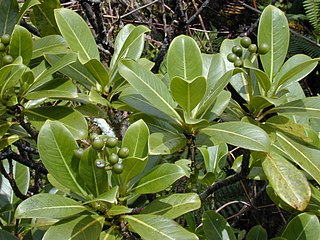
Psychotria mariniana, the forest wild coffee or kōpiko, is a tree endemic to Hawaiʻi. The plant belongs to the Rubiaceae (coffee) family, subfamily Rubioidae. It is a tree of varying size with a dark bark, shiny leaves, and orange oval fruit.
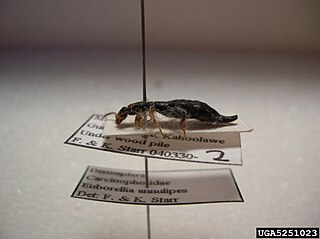
Anisolabidinae, alternatively known as Carcinophorinae, Gonolabiinae, or Placolabidinae, is a subfamily of earwigs containing 17 genera.
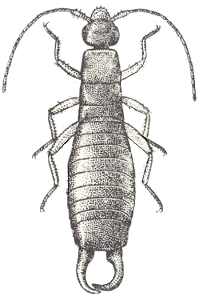
Anisolabis is a genus of mostly Asian earwigs in the subfamily Anisolabidinae. It was cited by Srivastava in Part 2 of Fauna of India. The name Anisolabis stems from the asymmetry of the male cerci; the right cercus being more acute than the left.

Remya is a genus of Hawaiian plants in the tribe Astereae within the family Asteraceae.
Anisolabis breviforceps is a species of earwig in the genus Anisolabis, the family Anisolabididae, and the order Dermaptera. It was first classified in 1979 by Brindle.
Anisolabis hawaiiensis is a species of earwig in the genus Anisolabis, the family Anisolabididae, and the order Dermaptera. The species is native to Hawaii, and was first classified by Brindle in 1979.
Anisolabis howarthi is a blind, troglobite species of earwig in the genus Anisolabis, the family Anisolabididae, and the order Dermaptera. The species is native to Hawaii, and was first classified by Brindle in 1979. According to a paper published by him in 1980 in the journal Pacific Insects, the species is first known true troglobite earwig; while there are other blind species that live underneath soil or humus, this is the first to actually inhabit a cave.

The seashore earwig is a species of earwig in the family Anisolabididae. The species was first described in 1846 by Adam White. This species has a blackish-brown body with brown-yellow legs. It has two light brown spots on its head, close to the inside of each eye. Its abdomen is widest at the seventh segment. It is flightless. It is native to eastern Australia and New Zealand. Similar both ecologically and taxonomically to the maritime earwig, this species is commonly found on beaches under stones and debris. It is a carnivore, feeding on millipedes, flies, and isopods such as woodlice. Like most other earwigs, the females care for their young during development, and the larva go through five instars before becoming adults. The species also has a negative phototaxis, meaning that it tends to move away from a light source.

Anisolabis maritima, commonly known as the maritime earwig or the seaside earwig, is a species of earwig in the family Anisolabididae. Similar to the seashore earwig, this species can be found near the shore line, and is cosmopolitan. It can be found in almost all biogeographic realms. Scientists believe that these earwigs originally came from Asia. Since then, however, they have been introduced to North America, and have now spread around the world due to international commerce.
Anisolabis oahuensis is a species of earwig in the genus Anisolabis, the family Anisolabididae, and the order Dermaptera.
The Pacific earwig is a species of earwig in the genus Anisolabis, the family Anisolabididae and the order Dermaptera.
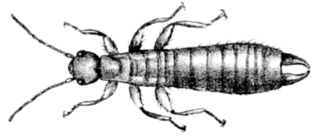
The Christmas Island earwig is a species of earwig in the family Anisolabididae.

Pustularia is a small genus of medium-sized sea snails or cowries, marine gastropod mollusks in the subfamily Pustulariinae of the family Cypraeidae, the cowries.

Cyrtulus mauiensis is a species of sea snail, a marine gastropod mollusk in the family Fasciolariidae, the spindle snails, the tulip snails and their allies.
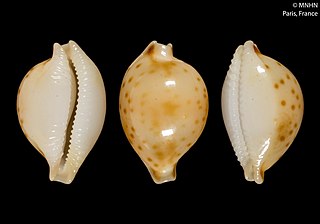
Pustularia mauiensis is a species of sea snail, a cowry, a marine gastropod mollusk in the family Cypraeidae, the cowries.
Remya mauiensis is a rare species of flowering plant in the family Asteraceae known by the common name Maui remya. It is endemic to Hawaii, where it is known only from the island of Maui. It is threatened by the degradation of its habitat. It is a federally listed endangered species of the United States.

Bidens mauiensis, common names Maui beggarticks and ko`oko`olau, is a herb in the family Asteraceae.

Trochocyathus is a genus of corals in the family Caryophylliidae. Living species are found in waters near Hawai'i at depths of 64 to 1,020 meters. Fossil species are found as far back as the latest Paleocene in the Dilwyn Formation of Australia, in the late Cretaceous in the Woodbury Formation of New Jersey, and in Suffolk.










